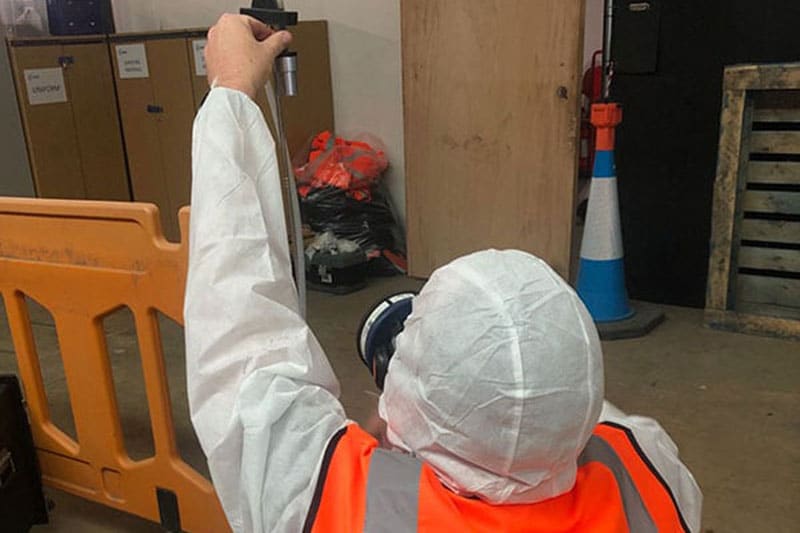What is asbestos static air testing? (And when would I need it?)

The term “static air testing” is another category of asbestos air testing that you might have heard of. Asbestos static air testing is concerned with assessing the concentration of airborne asbestos fibres in a particular environment. In this sense, it differs from personal air testing, which is carried out on individual persons, with the aim of testing the levels of respirable asbestos fibres in the air that the given individual is likely to be breathing in.
Whatever “type” or name of asbestos air testing you ultimately request from a reputable and accredited provider of this service, it can greatly support your efforts to identify the potentially dangerous asbestos fibres that could be lingering in the air at a given site.
The identification of such airborne asbestos can help ensure the health and safety of individuals who use or visit buildings where asbestos-containing materials (ACMs) are confirmed or suspected to be present.
Understanding asbestos static air testing
As we stated above, asbestos static air testing can be defined in opposition to personal air testing. This form of asbestos air monitoring is not focused on the level of asbestos exposure to which a specific person may be subject. Instead, it is used to measure the level of asbestos fibres in the air within a particular area or room.
Personal air testing – also often referred to as “personal sampling” – typically entails a filter holder being attached to the given individual’s clothing, as closely as practicable to their mouth and nose (ideally within 200mm).
Asbestos static air testing, meanwhile, does not have this focus on a specific person. Otherwise, the basic process of asbestos static air testing is relatively easy to understand. Highly trained and certified analysts attend the site where asbestos air monitoring is required, and use specialist equipment to capture samples of the air. These samples are then analysed under a microscope, so that the analysts can ascertain the level of asbestos fibres in the sampled air.
As you might imagine, specialist equipment is required for asbestos static air testing. These include the mechanical pump that is used to draw a measured volume of air through a filter measuring 25mm in diameter. This is followed by examination of the filter in a laboratory environment, with all observed fibres being measured, in order to determine which fibres are respirable.
Once the work has been done to count the correct size of the fibres, it will be possible for the concentration of the fibres in the sampled air to be calculated.
When is asbestos static air testing necessary?
The term “asbestos static air testing” is a relatively broad one that covers various categories of asbestos air monitoring. There are, then, a number of circumstances in which such static air testing may be needed. These include:
Prior to asbestos removal or disturbance
One “type” of static sampling is background sampling, which is carried out in order to establish the prevailing fibre concentration. It is frequently done prior to an activity that could lead to airborne asbestos contamination – for example, before any renovation or demolition work, given that such intrusive activity could cause disturbance to ACMs on the premises.
Background asbestos air testing, then, can be invaluable in that it establishes a useful “baseline” of measured asbestos levels in the air, with which other samples (for example, leak and reassurance samples) can be compared.
During asbestos removal projects
Static air monitoring is not only important prior to an asbestos removal operation taking place; ongoing monitoring during the work itself is similarly crucial. This process will help to ensure the control measures that have been implemented are genuinely effective in minimising the release of asbestos fibres.
Again, there are various names that can be applied to asbestos static air testing in this context. You may have heard, for instance, of the term “asbestos leakage air testing”, which is carried out directly outside of an asbestos removal enclosure.
The aim of this type of air testing is to assess the asbestos enclosure’s integrity, ensuring that it remains intact and airborne asbestos fibres are not escaping from the enclosure. It is typically the on-site asbestos analyst who takes leak-testing samples. This allows it to be confirmed that concentrations of fibres outside the enclosure are not too high.
After asbestos removal (clearance testing)
Another term frequently used in reference to asbestos static air testing, is “clearance testing”. Indeed, in cases of any licensed asbestos work having been carried out within an asbestos enclosure, it is a legal requirement for a four-stage clearance test to be undertaken. Asbestos clearance air testing is the third of these four stages.
When static air testing is used for such clearance purposes, the goal is to verify that the air is safe and meets regulatory standards for reoccupation after asbestos work.
In buildings with known ACMs
You might not necessarily only arrange for asbestos static air testing in situations where you know disturbance has definitely been caused to ACMs at premises for which you are responsible.
With asbestos having been banned for use in UK construction projects since 1999, the ACMs that are already in properties dating from prior to the year 2000 could be susceptible to deterioration as they age. This, in turn, could cause potentially dangerous fibres to be released from those asbestos-containing products, especially if it is believed that disturbance may have been caused to the ACMs.
As part of the regular surveying and ongoing management of asbestos on your premises, you might have identified certain ACMs that are not in the same condition as they were the last time you had an asbestos survey carried out. If so, it could be worth having a conversation with an asbestos professional, to determine whether now could be the time to arrange static air testing.
What are the benefits of asbestos static air testing?
One key – but far from insignificant – benefit that asbestos static air testing brings to building owners, occupants, and workers alike, is peace of mind.
Airborne asbestos fibres can have extremely serious implications for health if they are ingested or inhaled. These include an elevated risk of an individual who has been exposed to the substance developing a potentially fatal asbestos-related disease, such as mesothelioma or asbestos-related lung cancer, many years later.
So, if anyone who uses your site or workplace has reason to believe there may be a risk of such asbestos exposure – for example, in cases of possible accidental asbestos disturbance, or after asbestos removal work has been carried out – they are likely to be grateful for the reassurance that static air testing can bring. Everyone deserves to know that they are working in or visiting an environment that is genuinely safe from asbestos exposure.
Another crucial factor to consider, is that static air testing can help with your efforts to comply with health and safety regulations. Such pieces of legislation as the Health and Safety at Work Act 1974 and the Control of Asbestos Regulations 2012 put in place stringent legal requirements, and violations of these laws can lead to heavy fines or even a prison sentence.
What does the process of static air testing involve?
As we mentioned above, the general process of asbestos static air testing is broadly the same, whichever “type” of asbestos air monitoring you might request.
A mechanical pump will be used to draw a measured volume of air through a 25mm diameter filter, followed by examination of the filter under a microscope. The latter stage will involve the number of respirable fibres being manually counted, and all observed fibres being measured. These steps will allow for subsequent calculation of the fibres’ concentration in the sampled air.
Beyond this, there are certain other specifics you should be aware of, depending on the “type” of static air testing that is being carried out.
Clearance air testing, for example, differs from other forms of asbestos air monitoring, as there are specific requirements that must be complied with in cases where the legally required four-stage clearance process is being followed.
If you are looking to have such a clearance air test undertaken, a sample volume of at least 480 litres of air will need to be taken. Furthermore, this sample will need to produce results of less than 0.01 asbestos fibres per millilitre of air sampled. This is known as the “clearance indicator”. Achieving results at this threshold will be key to your efforts to confirm that the tested area is fit for normal reoccupation after asbestos removal work has been carried out.
For more in-depth information about what the static air testing process involves, including for specific “categories” of air monitoring such as reassurance sampling, clearance sampling, and/or background sampling (to cite just a few), we urge you to consult the Health and Safety Executive (HSE)’s Asbestos: The Analysts’ Guide. A free PDF copy of this publication, with the series code HSG248, can be downloaded from the HSE website.
Conclusion: static air testing can greatly contribute to asbestos safety efforts
Whatever “type” of static air testing you arrange for certain premises or areas for which you are responsible, you should be aware of the importance this form of asbestos testing can have. It can play a crucial role in ensuring a safe environment for occupants and workers in buildings where there could be a risk of coming into contact with asbestos.
In your capacity as an employer or property owner, you should be proactive in managing the potential asbestos risks at your workplace or premises. Professional asbestos consultancy services, such as those that Oracle Solutions can provide, could provide vital support for you in this goal.
Enquire to our team today via email or by calling us, and you will be able to quickly discuss your needs in relation to asbestos management with accredited experts. Furthermore, you will be able to schedule asbestos static air testing from us, if this service does turn out to be needed.

Written by Mark Carter
Mark Carter is a renowned expert in asbestos management, offering clients vital guidance on compliance and safety. His expertise is invaluable for navigating asbestos regulations, ensuring both safety and legal adherence. Mark's role is central in providing effective asbestos-related solutions, helping clients achieve their business objectives with an emphasis on regulatory compliance and safety in asbestos management.
